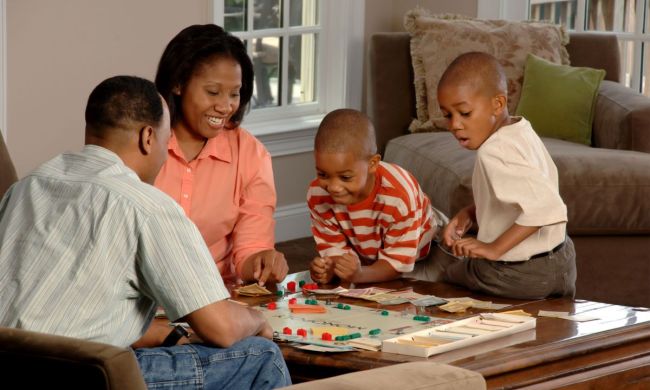Looking for a few new outdoor games to play with the family? With a big set of yard dice, you’ll have fun for days. These oversized but lightweight wooden dice are big, but easy for even the littles to play with. Adapt any traditional dice game or makeup your own yard dice rules for something completely new for backyard fun with children, teens, and adults. If you’re not sure where to start, we’ve got you covered with yard dice game instructions for ten great games you can go outside and play right now.
Yardzee
One or more players ages ten and up
Equipment: five yard dice and a Yardzee scoring sheet and pencil for each player
How to play
The object of Yardzee is to get the highest score from rolling the five dice. Each game has 13 rounds. The first player starts the game by rolling all of the dice. After rolling, the player has the option to score the current roll or re-roll any or all of the dice. Each player gets up to three rolls per turn.
On the scoring sheet, the player must choose one of the 13 categories in either the upper or lower section and record their score accordingly. Choose wisely! Once a category has been scored, it cannot be replaced in a later turn.
In the upper section of the scoring sheet, duplicates of the same number are added together for the score. For instance, if the roll was 3-2-3-5-3, it could be scored as 9 points in the upper section 3s category. In the lower section rolls are scored similarly to playing card games: three or four of a kind, full house, small straight, large straight, and Yardzee (five of a kind). At the end of 13 rounds, the top and bottom sections are totaled to determine the winner.
Yarkle
Two or more players ages ten and up
Equipment: six yard dice and one sheet of paper and pencil for scoring
How to play
Each player gets as many rolls as they like to accumulate points, but rolling a “Yarkle” sets your score back to zero. The first player to reach 10,000 points wins.
One player begins by rolling all six dice, then setting aside at least one die for scoring. After setting scoring dice aside, they may choose to roll the remaining dice or record the total score and pass play to the next player. To get on the board, a player must score 500 points in a turn, most players have to roll more than once on their first turn just to get in the game. On any turn, a player may roll as many times as they wish until they choose to record their accumulated points and pass, unless they score a Yarkle. Once all six dice have been set aside for scoring, the player may start with all six again.
A Yarkle is a roll that results in no scorable points, such as 2-2-3-3-4-6. Any time a player scores a Yarkle, all accumulated unscored points for the round are reset to zero and play passes to the next player. The player does not lose their scored points from previous turns. A player who rolls three Yarkles in a row loses 1,000 points from their score.
Each roll scores separately, even within a turn. If a player rolls three twos on their first attempt, then rolls a two in their second attempt, it is not counted as four of a kind. The only numbers that score individually are one and five. Scoring starts with three of a kind for other numbers. Point values are as follows:
One = 100
Five = 50
Three of a kind
Ones = 300
Twos = 200
Threes = 300
Fours = 400
Fives = 500
Sixes = 600
Three pairs = 1,500
Two triplets = 2,500
Four of a kind (any number) = 1,000
Five of a kind (any number) = 2,000
Six of a kind (any number) = 3,000
Four of a kind + a pair (any number) = 1,500
Straight (1-2-3-4-5-6) = 1,500
All other rolls = Yarkle, lose any points set aside for scoring and pass play to the next player
Snake Eyes
Two players or teams ages five and up
Equipment: six dice and a Hula hoop or rope to make a three foot circle
How to play
Lay the hoop or rope ring on the ground and determine a throwing line, about 10 feet away. Players alternate throwing all six dice toward the target. Each die that remains inside the ring at the end of throwing is scored at face value. The first team or player to 21 points wins. If a team throws all ones (snake eyes) in a single turn, they automatically win.
Beat That
Two or more players ages four and up
Equipment two or three yard dice, pencil and paper for scoring (optional)
How to play
The first player rolls the dice and then places them in order to create the highest possible number. For example, if the dice show two, six, and five, they can be arranged to make 652. The dice are passed to the next player with the challenge to “Beat that!” The player with the highest number wins the round and scores a point.
For older kids, add another die for larger numbers. Or, use the winning number as the score for each round. After completing a predetermined number of rounds, the player with the highest point total wins.
Twenty-One/Mexico
Two or more players ages eight and up
Equipment: two dice, tokens such as marbles, Halloween candy, or Legos
How to play
Each player starts out with the same number of tokens, and all players agree at the start how many tokens each round is worth. The first player can roll up to three times, and choose their highest score (but they may choose to roll only once or twice if they wish). Each following player can roll as many times as the first player did. At the end of the round, the player with the lowest score must place the agreed-upon number of tokens into the pot, and the next round begins. The last player that still has tokens wins, and they win the pot.
Going To Boston
Two or more players ages eight and up
Equipment: three dice and a pencil and paper for scoring
How to play
Players agree in advance on the number of rounds they will play. On each turn, the player rolls three times. After rolling all three dice, they set aside the high scoring die and roll the remaining two dice. They then set aside the higher of the two and roll the remaining one. The values of the three dice are totaled and recorded as that player’s score. The next player continues likewise. After the agreed upon number of rounds, scores are totaled to determine the winner.
Ship, Captain, and Crew
Two or more players ages 10 and up
Equipment: five dice and pencil and paper for scoring or tokens for each player
How to play
This could be a points game, or a gambling game. For points, score one for the winner of each round. For a gambling game, provide tokens for each player to start. Determine in advance the number of rounds to be played.
Each player gets three throws of the dice. Six represents the ship, five represents the captain, and four represents the crew. On a turn the player must roll six-five-four simultaneously or in descending order on successive throws to be able to load the ship with cargo. These numbers, when rolled, are set aside and are not rolled again by the player, except that they must be rolled in order. Five and four cannot be kept until six has been rolled. Four cannot be kept until six and five have been rolled.
If the player rolls six-five-four, the values of the other two dice are added together to determine a score. If the ship, captain, and crew were rolled on the first or second throw, the remaining two dice, the cargo, may be scored as they landed or rerolled to try for a better score. If the player chooses to reroll the cargo dice, they must take the latest score, even if it is lower. Players who do not roll the six-five-four sequence score zero.
At the end of the round there could be a tie between two or more players. In this case, each takes one additional turn until a winner is determined.
Balut
Two or more players ages 10 and up
Equipment: five dice, and a score sheet and pencil for each player
How to play
Balut is played in 28 rounds. On a turn, the player rolls the dice and scores the roll in one of seven categories, fours, fives, sixes, straight, full house, choice, and Balut (five of a kind). Through the game players must score four times in each category. At the end of the game, incentive points are awarded for meeting scoring minimums for each category. The player with the most points at the end of the game wins.
A player gets up to three rolls on a turn. They first throw all of the dice. They can then choose to record the score, or throw either all or some of the dice again a second or third time. After the final roll, that player’s score is recorded in one of the seven categories and play passes to the next player.
Each scoring category is scored by counting the eyes on the dice. In the fours, fives, and sixes category, the specified die face is totaled. For instance if the roll was four-two-one-four-three, the score under fours would be eight points. Straights are five consecutive numbers rolled, either one-two-three-four-five (15 points), or two-three-four-five-six (20 points). A full house is three of a kind and two pairs. Choice is a catch-all for which anything can be rolled and all dice values are totaled. If a player rolls a Balut (five of a kind), the score is the total face value of the dice plus 20 points.
Pig
Two to 10 players ages 8 and up.
Equipment: one six-sided die and a pencil and paper to keep score
How to play
Roll the die and accumulate points, but avoid rolling a one. On a turn, the player can roll the die as many times as they wish to accumulate points, unless they roll a one. After each roll, the player accumulates the number of points shown on the die. They can choose to hold the point total and pass play to the next player, or roll again to accumulate more points. But, if the player rolls a 1, they lose their points for that round and play passes to the next player. The winner is the first player to score at least 100 points.
Double Whammy
Four to six players ages 8 and up
Equipment: two dice and a challenge activity (this was originally a drinking game, but you could substitute pushups, or getting sprayed five seconds with the garden hose)
How to play
The magic number is six. On a turn the player rolls the dice. If the resulting combination adds up to six, or has a six in it, they must [insert challenge here] one time. If they roll double ones, twos, fours, or fives, they must [insert challenge here] one, two, four, or five times, accordingly. But if they roll double threes or double sixes, then they [insert challenge here] six times. The same player continues rolling until they get a combination that does not require a challenge.
These are just a few of the dice games your family can play together. There are scores, possibly hundreds of others out there to discover, or you can create new ones. Your next picnic or family reunion will be a blast when you break out the big dice.



